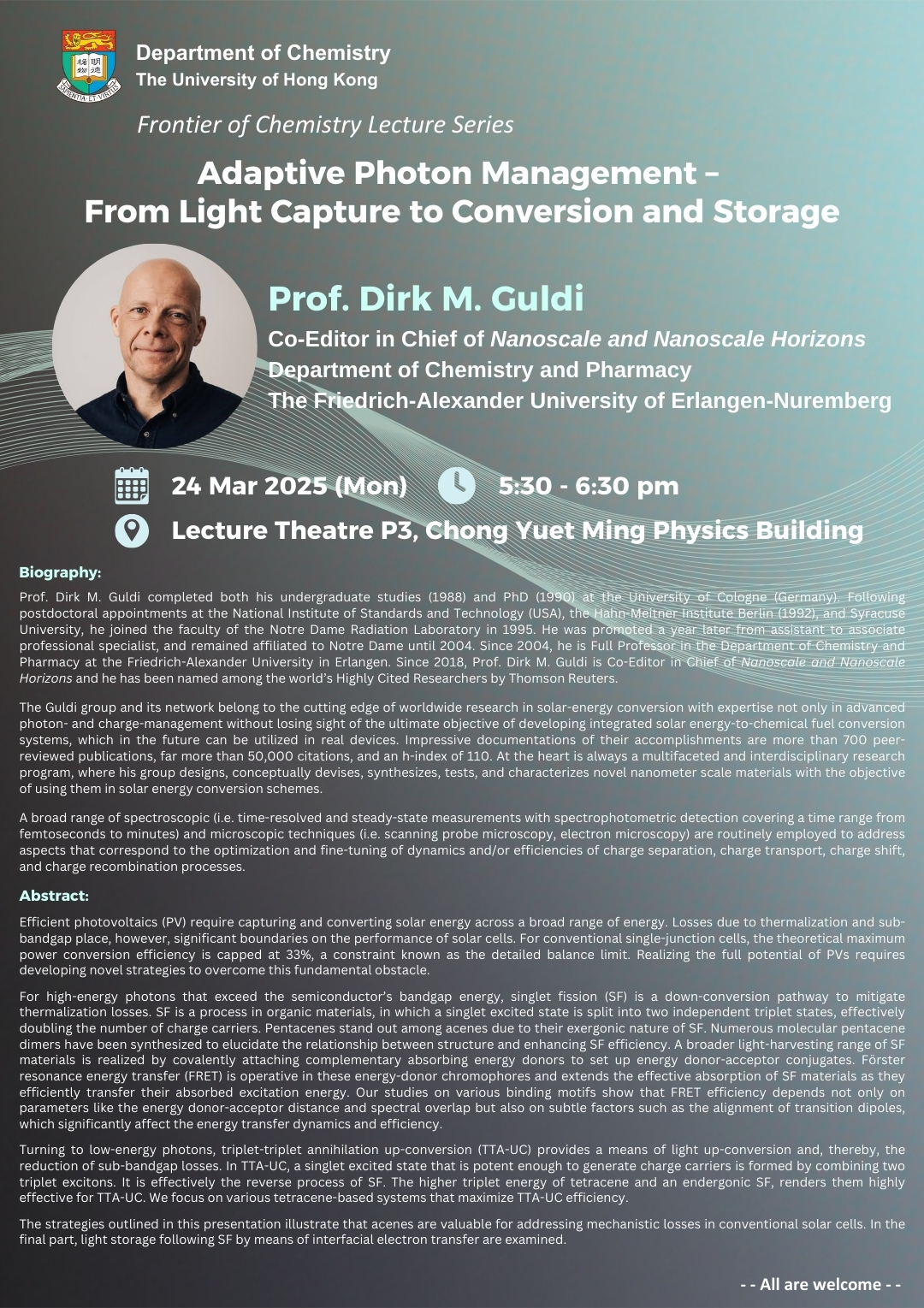| Date | 24 Mar 2025 |
| Time | 5:30 pm - 6:30 pm (HKT) |
| Venue | Lecture Theatre P3, Chong Yuet Ming Physics Building |
| Speaker | Prof. Dirk M. Guldi |
| Institution | Co-Editor in Chief of Nanoscale and Nanoscale Horizons Department of Chemistry and Pharmacy The Friedrich-Alexander University of Erlangen-Nuremberg |

Title:
Adaptive Photon Management – From Light Capture to Conversion and Storage
Schedule:
Date: 24thMarch, 2025 (Monday)
Time: 5:30 - 6:30 pm (HKT)
Venue: Lecture Theatre P3, Chong Yuet Ming Physics Building
Speaker:
Prof. Dirk M. Guldi
Co-Editor in Chief of Nanoscale and Nanoscale Horizons
Department of Chemistry and Pharmacy
The Friedrich-Alexander University of Erlangen-Nuremberg
Biography:
Prof. Dirk M. Guldi completed both his undergraduate studies (1988) and PhD (1990) at the University of Cologne (Germany). Following postdoctoral appointments at the National Institute of Standards and Technology (USA), the Hahn-Meitner Institute Berlin (1992), and Syracuse University, he joined the faculty of the Notre Dame Radiation Laboratory in 1995. He was promoted a year later from assistant to associate professional specialist, and remained affiliated to Notre Dame until 2004. Since 2004, he is Full Professor in the Department of Chemistry and Pharmacy at the Friedrich-Alexander University in Erlangen. Since 2018, Prof. Dirk M. Guldi is Co-Editor in Chief of Nanoscale and Nanoscale Horizons and he has been named among the world’s Highly Cited Researchers by Thomson Reuters.
The Guldi group and its network belong to the cutting edge of worldwide research in solar-energy conversion with expertise not only in advanced photon- and charge-management without losing sight of the ultimate objective of developing integrated solar energy-to-chemical fuel conversion systems, which in the future can be utilized in real devices. Impressive documentations of their accomplishments are more than 700 peer-reviewed publications, far more than 50,000 citations, and an h-index of 110. At the heart is always a multifaceted and interdisciplinary research program, where his group designs, conceptually devises, synthesizes, tests, and characterizes novel nanometer scale materials with the objective of using them in solar energy conversion schemes.
A broad range of spectroscopic (i.e. time-resolved and steady-state measurements with spectrophotometric detection covering a time range from femtoseconds to minutes) and microscopic techniques (i.e. scanning probe microscopy, electron microscopy) are routinely employed to address aspects that correspond to the optimization and fine-tuning of dynamics and/or efficiencies of charge separation, charge transport, charge shift, and charge recombination processes.
Abstract:
Efficient photovoltaics (PV) require capturing and converting solar energy across a broad range of energy. Losses due to thermalization and sub-bandgap place, however, significant boundaries on the performance of solar cells. For conventional single-junction cells, the theoretical maximum power conversion efficiency is capped at 33%, a constraint known as the detailed balance limit. Realizing the full potential of PVs requires developing novel strategies to overcome this fundamental obstacle.
For high-energy photons that exceed the semiconductor’s bandgap energy, singlet fission (SF) is a down-conversion pathway to mitigate thermalization losses. SF is a process in organic materials, in which a singlet excited state is split into two independent triplet states, effectively doubling the number of charge carriers. Pentacenes stand out among acenes due to their exergonic nature of SF. Numerous molecular pentacene dimers have been synthesized to elucidate the relationship between structure and enhancing SF efficiency. A broader light-harvesting range of SF materials is realized by covalently attaching complementary absorbing energy donors to set up energy donor-acceptor conjugates. Förster resonance energy transfer (FRET) is operative in these energy-donor chromophores and extends the effective absorption of SF materials as they efficiently transfer their absorbed excitation energy. Our studies on various binding motifs show that FRET efficiency depends not only on parameters like the energy donor-acceptor distance and spectral overlap but also on subtle factors such as the alignment of transition dipoles, which significantly affect the energy transfer dynamics and efficiency.
Turning to low-energy photons, triplet-triplet annihilation up-conversion (TTA-UC) provides a means of light up-conversion and, thereby, the reduction of sub-bandgap losses. In TTA-UC, a singlet excited state that is potent enough to generate charge carriers is formed by combining two triplet excitons. It is effectively the reverse process of SF. The higher triplet energy of tetracene and an endergonic SF, renders them highly effective for TTA-UC. We focus on various tetracene-based systems that maximize TTA-UC efficiency.
The strategies outlined in this presentation illustrate that acenes are valuable for addressing mechanistic losses in conventional solar cells. In the final part, light storage following SF by means of interfacial electron transfer are examined.
- - ALL ARE WELCOME - -
